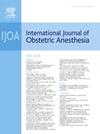Evaluation of the relationship between the Obstetric Comorbidity Index (Ob-CMI) and the Obstetric Quality Of Recovery Score (ObsQoR-11): a prospective observational study
IF 2.3
3区 医学
Q2 ANESTHESIOLOGY
引用次数: 0
Abstract
Background
Caesarean delivery is a common surgical procedure associated with significant maternal morbidity and mortality. Delayed postoperative recovery is a critical concern influenced by various factors. This study evaluates whether the Obstetric Comorbidity Index (OB-CMI) predicts postoperative recovery quality, hypothesizing a correlation with the Obstetric Quality of Recovery score (ObsQoR-11).
Methods
In our prospective observational study, patients’ demographic data, medical history, ASA score, gravida, parity, gestational age, caesarean delivery category and indication if emergency, OB-CMI, anaesthesia method, intraoperative bleeding and transfusion of blood products, complications, postoperative analgesia use, the duration of hospitalization, the need for admission to intensive care unit and duration (if applicable) and the discharge status were recorded. The primary outcome was the correlation between OB-CMI and ObsQoR-11 scores on postoperative days 1 and 2. Secondary outcomes included comparisons of ObsQoR-11 scores across caesarean categories and anaesthesia techniques.
Results
There were 214 patients included in this study. A negative significant correlation was found between the OB-CMI and the ObsQoR-11 score on day 1 (R: -0.286, P <0.001) and day 2 (R: -0.225, P =0.001). The OB-CMI was found to be significantly lower in patients who received neuraxial anaesthesia compared to those who received general anesthesia (P =0.009). The ObsQoR-11 score was found to be significantly lower in patients who received general anaesthesia compared to patients who received neuraxial anaesthesia.
Conclusion
A negative correlation between preoperative OB-CMI and postoperative ObsQoR-11 scores suggests that OB-CMI may serve as a valuable preoperative tool for predicting recovery quality in caesarean delivery cases.
评估产科合并症指数(Ob-CMI)与产科康复质量评分(ObsQoR-11)之间的关系:一项前瞻性观察研究
背景剖宫产是一种常见的外科手术,与显著的产妇发病率和死亡率相关。术后恢复延迟是一个受多种因素影响的关键问题。本研究评估产科共病指数(OB-CMI)是否预测术后恢复质量,并假设与产科恢复质量评分(ObsQoR-11)相关。方法在前瞻性观察研究中,记录患者的人口学资料、病史、ASA评分、妊娠、胎次、胎龄、剖宫产类别及急诊指征、OB-CMI、麻醉方式、术中出血及输血血制品、并发症、术后使用镇痛药、住院时间、是否需要入住重症监护病房及入住时间(如适用)、出院情况。主要结局是术后第1天和第2天OB-CMI和ObsQoR-11评分之间的相关性。次要结局包括比较剖宫产类别和麻醉技术的ObsQoR-11评分。结果共纳入214例患者。OB-CMI与ObsQoR-11评分在第1天(R: -0.286, P <0.001)和第2天(R: -0.225, P =0.001)呈显著负相关。与接受全身麻醉的患者相比,接受轴向麻醉的患者OB-CMI显著降低(P =0.009)。研究发现,接受全身麻醉的患者的ObsQoR-11评分明显低于接受神经轴向麻醉的患者。结论术前OB-CMI与术后ObsQoR-11评分呈负相关,提示OB-CMI可作为预测剖宫产患者术前恢复质量的重要工具。
本文章由计算机程序翻译,如有差异,请以英文原文为准。
求助全文
约1分钟内获得全文
求助全文
来源期刊
CiteScore
4.70
自引率
7.10%
发文量
285
审稿时长
58 days
期刊介绍:
The International Journal of Obstetric Anesthesia is the only journal publishing original articles devoted exclusively to obstetric anesthesia and bringing together all three of its principal components; anesthesia care for operative delivery and the perioperative period, pain relief in labour and care of the critically ill obstetric patient.
• Original research (both clinical and laboratory), short reports and case reports will be considered.
• The journal also publishes invited review articles and debates on topical and controversial subjects in the area of obstetric anesthesia.
• Articles on related topics such as perinatal physiology and pharmacology and all subjects of importance to obstetric anaesthetists/anesthesiologists are also welcome.
The journal is peer-reviewed by international experts. Scholarship is stressed to include the focus on discovery, application of knowledge across fields, and informing the medical community. Through the peer-review process, we hope to attest to the quality of scholarships and guide the Journal to extend and transform knowledge in this important and expanding area.

 求助内容:
求助内容: 应助结果提醒方式:
应助结果提醒方式:


